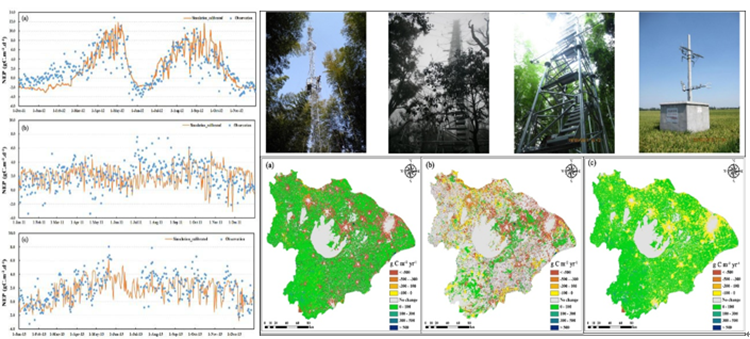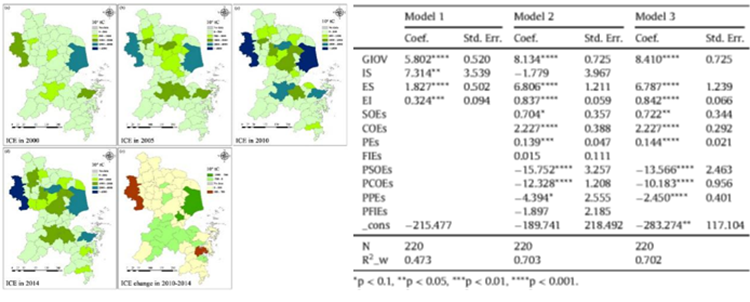NIGLAS Researchers Made Progress in the Influence of LUCC on Carbon Cycle in the Taihu Lake Basin of China and the Industrial Carbon Emissions in the Yangtze River Delta of China
Land use change (LUCC) is an important contributor to global carbon emissions, accounting for about 32% of global carbon emissions. How and to waht extent LUCC affects carbon cycle of the terrestrial ecosystem has become one of the hot issues for research on land use change and ecological effects. Located in the core area of the Yangtze River Delta, the Taihu Lake Basin of China is the most populous and developed region with the most intensive land and the fastest land use change. In the past 25 years, the large-scale urbanization in the Taihu Lake Basin strongly disturbed the terrestrial ecosystem of the basin. The influences of LUCC that characterizes the transfer from farmland to construction land and the continuous increasing of the development strength in the Taihu Lake Basin on basin carbon pattern are still not clear. The associate researcher Xu Xibao of our Institute established eddy-related carbon flux automatic observation system in terms of typical land use types in the Taihu Lake Basin (alternative rice and wheat farmland, bamboo forest as well as coniferous and broad-leaved mixed forest) by self-establishing and sharing to analyze key processes and influence mechanism of carbon cycle of typical land use types and to use the carbon flux data continuously observed to calibrate and correct Biome-BGC ecological process model. In order to distinguish between the effects of LUCC and environmental factors (atmospheric CO2 concentration/nitrogen settlement concentration) on the net ecosystem production (NEP), two different scenarios are set up: the scenario 1 considers the comprehensive influence of changes in LUCC and atmospheric CO2 concentration/nitrogen settlement concentration on NEP; the scenario 2 only considers the influence of LUCC on NEP while the atmospheric CO2 concentration/nitrogen settlement concentration is set to be level of 1985 and is constant. The two scenarios simulations take the five-year average to remove the influence of meteorological factors on NEP. The research results shows that the total NEP in the Taihu Lake Basin from 1985 to 2010 decreased from 16.1TgC in 1985 to 14.5TgC in 2010, decreasing by 1.57TgC (9.8%). The LUCC resulted in a NEP decrease of 3.06TgC (21.7%) and the atmospheric CO2 concentration/nitrogen settlement concentration rising increased NEP by 1.55TgC, accounting for 50% of total NEP decrease by LUCC. The research is supported by the key project (41030745) and the surface project (41371532) of the National Natural Science Foundation of China and the research achievements are published in the Journal of Geophysical Research: Biogeosciences, a mainstream journal in geosciences (TOP, IF=3.318).

Fig. 1 Carbon Flux Observation and Model Calibration and Region Simulation of Taihu Lake Basin (Image by NIGLAS)
Xibao Xu, Guishan Yang, Yan Tan, et al., 2017. Impacts of land use changes on net ecosystem production in the Taihu Lake Basin of China from 1985 to 2010. Journal of Geophysical Research: Biogeosciences, 122, doi:10.1002/2016JG003444.
Industry is China's largest energy consumption and carbon emissions sector In 2014, the industry energy consumption accounted for 70% of the total national energy consumption. The Yangtze River Delta is one of the three core urban agglomerations in China with its land area, population and GDP respectively accounting for 1.2%, 8.1% and 15.9% of the country. The energy consumption and the carbon emissions respectively account for 17.5% and 15.5% of the national total energy consumption and carbon emissions. There is a very serious challenge and task for regional energy-saving and emission reduction. This research uses the energy consumption data of the industrial sector to estimate and identify the characteristics of spatial and temporal patterns of industrial carbon emissions (ICE) in the Yangtze River Delta from 2000 to 2014. Comprehensively considering the industrial output value (GIOV), industrial structure (IS), energy intensity (EI), energy structure (ES), industrial enterprise composition (quantity/proportion) (state-owned enterprises, collective enterprises, private enterprises and foreign enterprises), three panel models are established based on the county scale to reveal key factors and their contributions to industrial carbon emissions in the Yangtze River Delta, which can be helpful to clarify the energy-saving and emission reduction path in the Yangtze River Delta. The research results show that: (1) Industrial carbon emissions in the Yangtze River Delta increased generally from 135.94 Mt CO2 in 2000 to 421.03 Mt CO2 in 2014 with an increase of 2.1 times; (2) The spatial pattern of industrial carbon emission was basically consistent with the “Z”-shape urban spatial pattern of the Yangtze River Delta. From 2000 to 2010, the industrial carbon emissions of all cities and counties increased. From 2010 to 2014, the industrial carbon emissions of 17 cities and counties decreased, mainly in Shanghai, Huzhou, Wuxi , Hangzhou and Cixi, accounting for 85.6% of the total carbon reduction in the Yangtze River Delta. However, the carbon emissions of small and medium-sized cities, represented by Ninghai, Zhenjiang, Changshu and Zhangjiagang and Pinghu, showed a significant growth trend, accounting for 54.8% of the total growth of carbon emissions in the Yangtze River Delta; (3) The industrial carbon emissions in the Yangtze River Delta were mainly affected by the total industrial output value, energy structure, energy intensity and enterprise composition (state-owned enterprises, collective enterprises and self-owned enterprises) and the industrial structure and the quantity/proportion of foreign enterprises and the carbon emissions are not significant. The research was supported by the surface project (41371532) of the National Natural Science Foundation of China and the 135-field frontier project (NIGLAS2012135019) of our Institute. The research achievements were published in the Journal of Cleaner Production (IF=4.959), a mainstream journal in the field of environmental sciences.

Fig. 2 Temporal and Spatial Change Pattern and Key Factor Contribution of Industrial Carbon Emissions in the Yangtze River Delta of China (Image by NIGLAS)

 Xibao Xu, Guishan Yang, Yan Tan, et al., 2017. Factors influencing industrial carbon emissions and strategies for carbon mitigation in the Yangtze River Delta of China. Journal of Cleaner Production, 142: 3607-3616.
Xibao Xu, Guishan Yang, Yan Tan, et al., 2017. Factors influencing industrial carbon emissions and strategies for carbon mitigation in the Yangtze River Delta of China. Journal of Cleaner Production, 142: 3607-3616.
